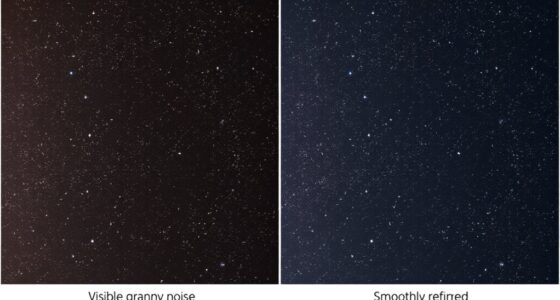When you stretch the histogram of an image, you convert linear pixel data into a non-linear distribution, which helps improve contrast and detail visibility. This process redistributes pixel intensities across the full dynamic range, making subtle features stand out. Normalization guarantees your data fits within this range, preventing skewing by outliers. If you keep exploring, you’ll discover how this transformation enhances image quality and reveals hidden details effectively.
Key Takeaways
- Histogram stretching converts linear, evenly spaced pixel data into a non-linear distribution to enhance contrast and detail.
- It redistributes pixel intensities, expanding narrow value ranges to utilize the full dynamic spectrum.
- Non-linear transformations emphasize subtle features by adjusting pixel values away from original linear spacing.
- Proper normalization before stretching ensures outliers do not skew the non-linear redistribution.
- The process improves visual clarity by balancing contrast across the entire image’s intensity range.

Have you ever wondered how digital images modify their brightness and contrast? When you view a photo that seems too dull or overly harsh, the solution often lies in a technique called histogram transformation. One common method is contrast stretching, which re-maps pixel intensity values to enhance image clarity. Contrast stretching works by expanding the range of pixel values, making dark areas darker and bright areas brighter. This process effectively improves the visibility of details, especially in images where pixel intensities are clustered within a narrow range. To do this efficiently, you need to perform data normalization first, which involves adjusting the data to fit within a specific range, typically from 0 to 255 for 8-bit images. Normalization guarantees that the entire spectrum of pixel values is utilized, enabling more effective contrast stretching. Additionally, understanding the underlying data distribution can help tailor the transformation for optimal results.
When you apply contrast stretching, you’re fundamentally transforming the original linear data distribution into a non-linear form that better highlights important features. In linear data, pixel values are evenly spaced, but this often results in images that lack contrast or detail. By contrast, non-linear transformations like contrast stretching redistribute pixel intensities, accentuating differences and making subtle variations more visible. Data normalization acts as a preparatory step, ensuring that the pixel values are scaled appropriately before the stretching process begins. This prevents the stretching from being skewed by outliers or uneven data distribution and guarantees the full dynamic range is utilized. As a result, the image appears more balanced, with details more distinguishable across the entire intensity spectrum.
Frequently Asked Questions
How Does Histogram Stretching Compare to Other Data Normalization Methods?
You find histogram stretching effective for contrast enhancement and expanding the dynamic range of your data. Unlike methods like normalization or standardization, it directly enhances image contrast by redistributing pixel intensities. This makes details more visible, especially in low-contrast areas. While other techniques might standardize data for analysis, histogram stretching specifically improves visual quality, making it ideal for images where contrast and dynamic range are essential.
Can Histogram Transformation Be Applied to Color Images?
Yes, you can apply histogram transformation to color images. It helps improve color balance and enhances visual quality by adjusting each color channel’s histogram individually or collectively. This process boosts contrast and makes images more vibrant, leading to better visual enhancement. Just make certain you handle each channel carefully to avoid color distortions, and you’ll achieve a more balanced, eye-catching result.
What Are Common Pitfalls When Applying Histogram Stretching?
Did you know that improper histogram stretching can reduce your image’s contrast by up to 30%? When applying histogram stretching for contrast enhancement, you should watch out for pitfalls like over-enhancement, which causes loss of detail, and ignoring the dynamic range, leading to unnatural-looking images. Always adjust carefully to improve contrast without sacrificing important information, ensuring your image retains a natural and balanced appearance.
How Does Histogram Equalization Differ From Stretching?
You’ll find that histogram equalization differs from stretching by focusing on contrast enhancement through intensity redistribution. While stretching linearly adjusts pixel values to cover a broader range, equalization redistributes intensities to produce a more uniform histogram. This results in improved detail in darker or brighter regions, making features stand out more clearly. Equalization offers a more automated approach, whereas stretching requires manual tuning for specific contrast improvements.
Is Histogram Stretching Suitable for Real-Time Data Processing?
Yes, histogram stretching is suitable for real-time data processing because it allows for dynamic adjustment of image contrast quickly. You can implement it efficiently, as it involves simple calculations that don’t demand extensive computational resources. This makes it ideal for applications where speed matters, such as live video feeds or real-time image enhancement, enabling you to improve image quality instantly without sacrificing performance.
Conclusion
By stretching the histogram, you effectively reveal hidden details in your data, making patterns more apparent. Did you know that applying non-linear transformations can sometimes double the visibility of subtle features? This technique empowers you to analyze complex datasets more intuitively. So, next time you face a bland, uninformative histogram, remember that a simple transformation could uncover a treasure trove of insights, transforming your understanding with just a few adjustments.









